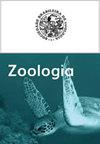巴西东北部雕刻无足虫(蜱螨目:伊蚊科)宿主蝙蝠及其对蜱传疾病的影响
IF 1.8
4区 生物学
Q4 ZOOLOGY
引用次数: 3
摘要
Amblyomma Koch, 1844分布在世界各地,目前已知约130种。这些蜱虫是动物和人类病原体的载体,包括新世界落基山斑疹热的病原体。两眼蝇寄生于多种生物,尤其是大中型陆生哺乳动物。本文首次报道了Myotis lavali Moratelli, Peracchi, Dias & Oliveira, 2011, Noctilio albiventris Desmarest(1818)和Noctilio leporinus (Linnaeus, 1758)作为Amblyomma sculptum Berlese(1888)宿主的关联。2011年,这种蜱最初被确定为卡詹氏Amblyomma cajenense (fabicius, 1787)。然而,后来的分类研究表明,在Caatinga中出现的a . cajenense复合体的种是a . sculptum。我们还讨论了这种关联的生态流行病学含义。本文章由计算机程序翻译,如有差异,请以英文原文为准。
Bats used as hosts by Amblyomma sculptum (Acari: Ixodidae) in Northeastern Brazil and its implications on tick-borne diseases
Amblyomma Koch, 1844 is distributed worldwide, with ca. 130 species currently recognized. These ticks are vectors of pathogens to animals and humans, including the causative agent of the New World Rocky Mountain spotted fever. Species of the Amblyomma parasitize a wide range of organisms, especially medium and large terrestrial mammals. Here we report for the first time the association of Myotis lavali Moratelli, Peracchi, Dias & Oliveira, 2011, Noctilio albiventris Desmarest, 1818 and Noctilio leporinus (Linnaeus, 1758) as hosts for Amblyomma sculptum Berlese, 1888. The ticks were originally identified as Amblyomma cajennense (Fabricius, 1787), in 2011. However, a later taxonomic review indicated that the species of the A. cajennense complex occurring in the Caatinga is A. sculptum. We also discuss the ecoepidemiological implications of this association.
求助全文
通过发布文献求助,成功后即可免费获取论文全文。
去求助
来源期刊

Zoologia
生物-动物学
自引率
0.00%
发文量
15
期刊介绍:
Zoologia, the scientific journal of the Sociedade Brasileira de Zoologia (SBZ), is an international peer-reviewed, open-access Zoological journal that publishes original research on systematics, evolution, taxonomy, nomenclature, biogeography, morphology, physiology, biology, ecology, symbiosis, conservation, behavior, genetics and allied fields. The journal, formerly known as Revista Brasileira de Zoologia, publishes original articles authored by both members and non-members of the Society. The manuscripts should be written exclusively in English.
 求助内容:
求助内容: 应助结果提醒方式:
应助结果提醒方式:


